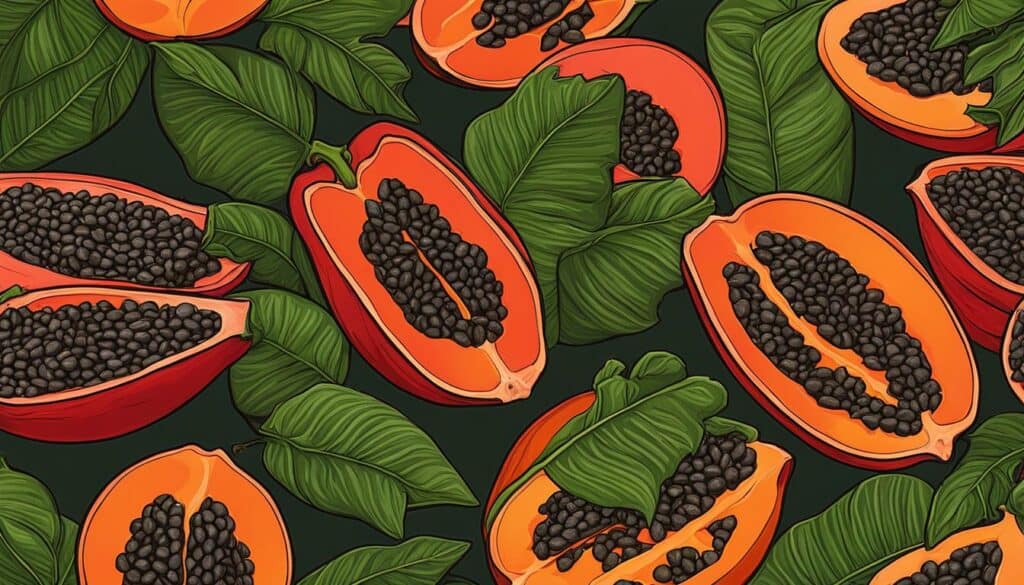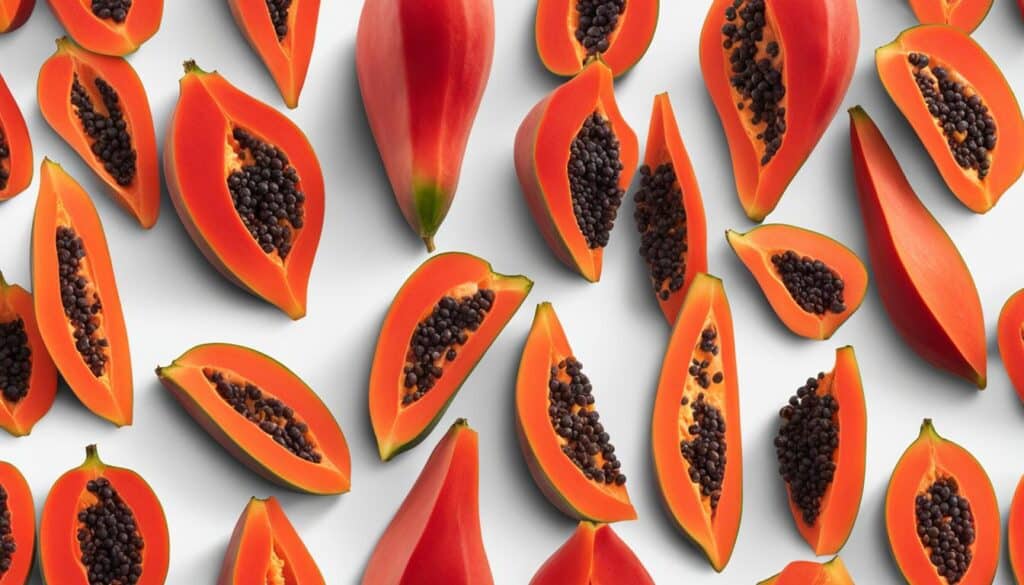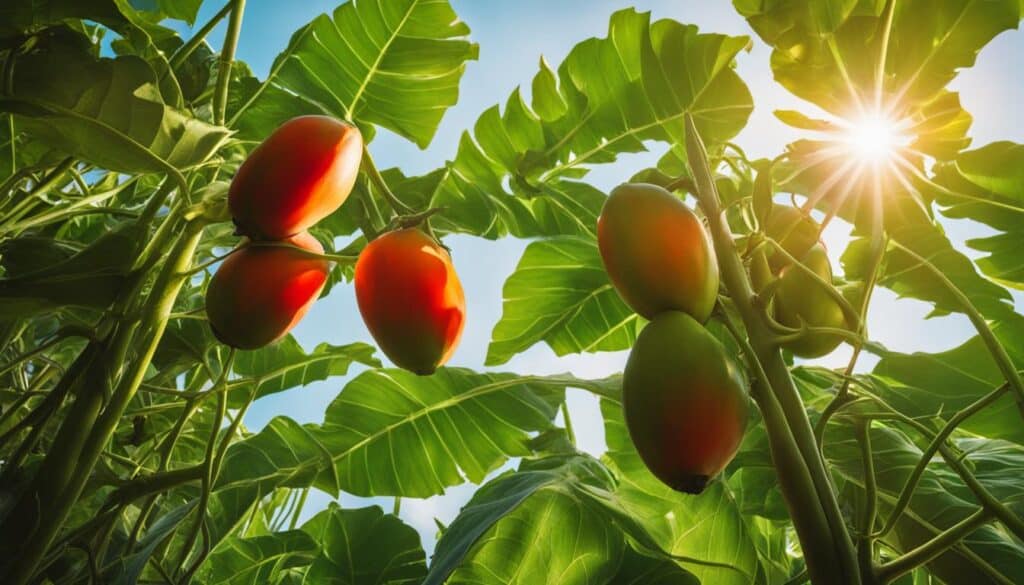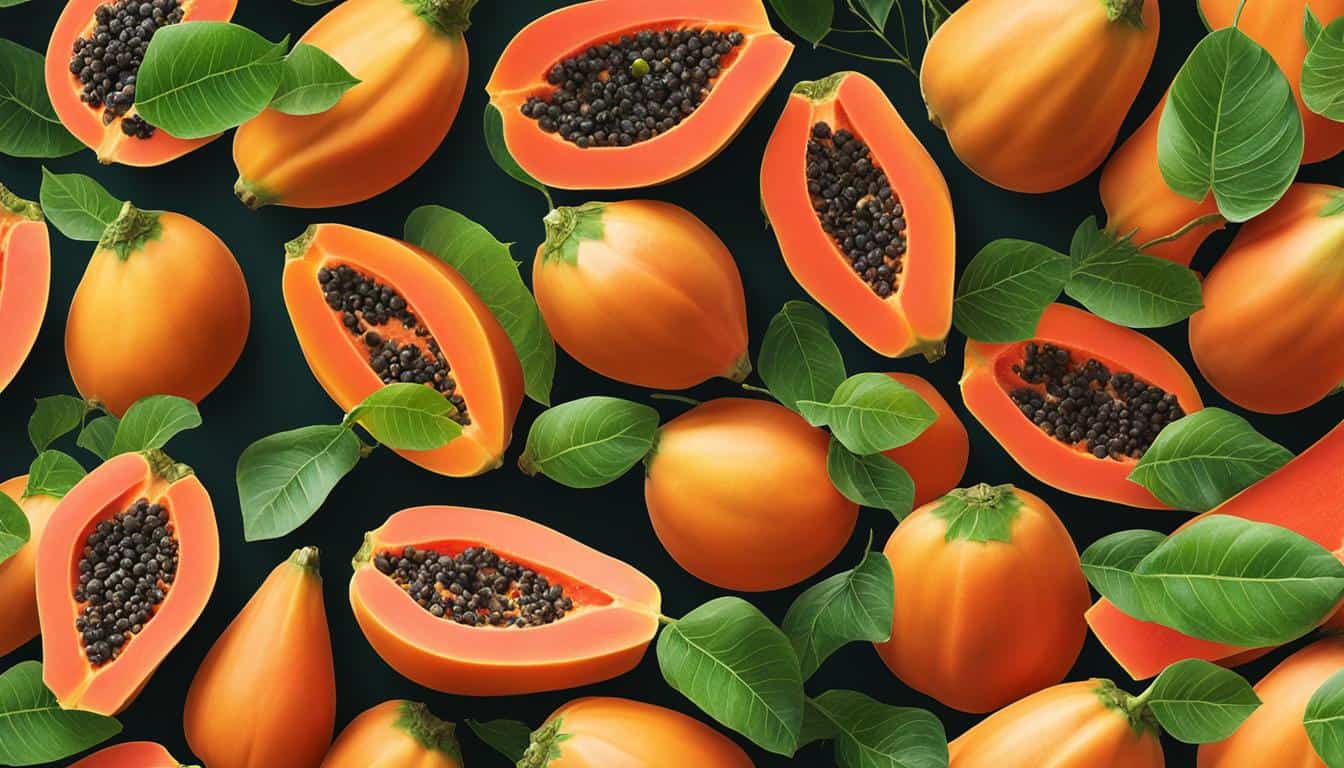Red Lady Papaya, also known as Carica papaya ‘Red Lady’ or Pawpaw ‘Red Lady’, is a strikingly beautiful fruit tree that produces luscious and tropical papaya fruits. The Red Lady Papaya has a sweet and tart taste that is truly unique and delightful. Not only does it offer an amazing flavor experience, but it also provides numerous health benefits. Packed with essential nutrients, vitamins, and antioxidants, Red Lady Papaya is known for its ability to boost immunity, support digestion, and promote healthy skin. Incorporating Red Lady Papaya into your diet can be a delicious and nutritious way to enhance your well-being.
Key Takeaways:
- Red Lady Papaya offers a unique and delightful sweet and tart taste.
- It provides numerous health benefits and is packed with essential nutrients, vitamins, and antioxidants.
- Incorporating Red Lady Papaya into your diet can boost immunity, support digestion, and promote healthy skin.
- Red Lady Papaya is a luscious and tropical fruit that enhances overall well-being.
- Experience the amazing flavor and health benefits of Red Lady Papaya today!
The Benefits of Red Lady Papaya
Red Lady Papaya is a nutritional powerhouse that offers a wide range of health benefits. It is rich in vitamin C, which supports immune function and collagen production. The fruit also contains vitamin A, which is essential for eye health and immune function. Additionally, Red Lady Papaya is a good source of dietary fiber, promoting digestive health and preventing constipation. It also contains enzymes like papain, which aids in the digestion of proteins. The antioxidants present in Red Lady Papaya help reduce oxidative stress and lower the risk of chronic diseases. Overall, incorporating Red Lady Papaya into your diet can improve your overall health and well-being.
Red Lady Papaya is not only delicious but also packed with essential nutrients. Here is an overview of the key nutritional components found in this tropical fruit:
| Nutrient | Amount per 100g |
|---|---|
| Vitamin C | 103.8 mg |
| Vitamin A | 950 IU |
| Fiber | 1.7 g |
| Papain | 24.5 mg |
These nutrients contribute to the numerous health benefits associated with Red Lady Papaya. Vitamin C supports the immune system, promotes collagen production for healthy skin, and acts as a powerful antioxidant. Vitamin A is essential for good vision and immune function. The dietary fiber in Red Lady Papaya aids in digestion and helps maintain a healthy weight. The enzymes present in the fruit, such as papain, assist in protein digestion and improve nutrient absorption.
The antioxidants found in Red Lady Papaya help neutralize harmful free radicals in the body, reducing the risk of chronic diseases such as heart disease and certain types of cancer. Additionally, the fruit’s high fiber content promotes bowel regularity, preventing constipation and supporting a healthy digestive system. Including Red Lady Papaya in your diet is a flavorful way to enhance your overall well-being and enjoy the numerous health benefits it offers.
Growing Red Lady Papaya
Red Lady Papaya is a tropical fruit that can be easily grown in your own backyard. Whether you choose to start from seeds or young plants, here are some tips to help you successfully grow Red Lady Papaya:
Planting Red Lady Papaya
- Choose high-quality Red Lady Papaya seeds or young plants from a reputable source.
- Plant the seeds or young plants in well-draining soil with a pH level between 6 and 7.
- Ensure the planting location receives plenty of sunlight, as Red Lady Papaya thrives in warm and sunny environments.
- Water the plants regularly to keep the soil moist, but avoid overwatering as it can lead to root rot.
With proper care and attention, your Red Lady Papaya plants will grow into healthy and productive trees.
Caring for Red Lady Papaya
Once your Red Lady Papaya plants begin to grow, it’s important to provide them with proper care to ensure optimal growth and fruit production:
- Prune the plants regularly to maintain their shape, remove dead or diseased branches, and encourage fruit production.
- Protect the plants from extreme weather conditions, such as strong winds or frost, as they can damage the trees.
- Monitor the plants for any signs of diseases or nutrient deficiencies, and take appropriate measures to address them.
- Fertilize the plants with a balanced fertilizer to provide them with essential nutrients.
By following these tips, you can enjoy the satisfaction of growing your own Red Lady Papaya and savoring the delicious fruits it produces.

| Red Lady Papaya Growing Tips | Red Lady Papaya Farming |
|---|---|
| Choose high-quality seeds or young plants. | Start with seeds or young plants from a reputable source. |
| Plant in well-draining soil with a pH level between 6 and 7. | Ensure the soil is well-draining and has a pH level between 6 and 7. |
| Provide plenty of sunlight for the plants to thrive. | Choose a sunny location for optimal growth. |
| Water regularly to keep the soil moist, but avoid overwatering. | Water regularly, but avoid overwatering to prevent root rot. |
| Prune regularly to maintain shape and encourage fruit production. | Regular pruning keeps the trees healthy and productive. |
| Protect from extreme weather conditions. | Take measures to protect the trees from strong winds and frost. |
| Monitor for diseases and nutrient deficiencies. | Keep an eye out for diseases and nutrient deficiencies. |
| Fertilize with a balanced fertilizer. | Use a balanced fertilizer to provide essential nutrients. |
Red Lady Papaya Recipes
Red Lady Papaya, with its sweet and tangy flavor, is a versatile fruit that can be used in a variety of delicious recipes. Whether you’re looking for a refreshing snack, a vibrant addition to salads, or a tropical twist to your desserts, Red Lady Papaya is sure to satisfy your taste buds. Here are some exciting recipes that showcase the unique taste and versatility of this tropical fruit:
Papaya Salsa
Kickstart your meal with a vibrant and flavorful Papaya Salsa. Combine diced Red Lady Papaya with tomatoes, red onions, jalapenos, cilantro, lime juice, and a hint of salt for a refreshing and zesty salsa. This versatile salsa pairs well with grilled chicken, fish, or can be enjoyed with tortilla chips as a tasty appetizer.
Papaya Smoothie Bowl
For a nutritious and Instagram-worthy breakfast, try a Papaya Smoothie Bowl. Blend ripe Red Lady Papaya with frozen berries, a splash of coconut milk, and a handful of spinach for a vibrant and nutrient-packed smoothie base. Pour the smoothie into a bowl and top it with your favorite toppings such as granola, sliced bananas, chia seeds, and a drizzle of honey. This smoothie bowl is not only visually appealing but also a delicious way to start your day.
Grilled Papaya with Honey and Lime
Elevate your grilling game with Grilled Papaya drizzled with honey and lime. Cut Red Lady Papaya into thick slices, brush them with a mixture of honey and lime juice, and grill them until slightly charred. The heat intensifies the sweetness of the papaya while the honey and lime add a delightful tanginess. Serve the grilled papaya slices as a side dish to complement grilled meats or enjoy them on their own as a unique and healthy dessert.
These are just a few examples of the many delicious recipes you can create using Red Lady Papaya. Whether you prefer it in a salsa, smoothie bowl, or grilled, this tropical fruit is sure to add a burst of flavor and tropical goodness to your culinary creations.
Red Lady Papaya Price
When it comes to purchasing Red Lady Papaya, the price can vary depending on various factors. The cost of Red Lady Papaya is influenced by factors such as location, season, and availability. While Red Lady Papaya is considered a premium variety of papaya, the unique taste, nutritional benefits, and overall quality of the fruit make it worth the investment.
It is recommended to check with local farmers’ markets, grocery stores, or online retailers for the current pricing of Red Lady Papaya in your area. Prices may fluctuate based on the supply and demand, so it’s always a good idea to compare prices and find the best option that suits your budget. Keep in mind that the price of Red Lady Papaya may be slightly higher compared to other papaya varieties due to its exceptional flavor and nutritional value.
Enjoying the delicious and nutritious Red Lady Papaya is truly a rewarding experience that is worth every penny!

About the Image:
The image above features a vibrant and ripe Red Lady Papaya, showcasing its luscious orange flesh and distinctive shape. The image serves as a visual representation of the Red Lady Papaya variety and its appeal to fruit enthusiasts. It captures the essence of the fruit and its enticing qualities, enticing readers to explore the world of Red Lady Papaya.
Red Lady Papaya Seeds
If you’re interested in growing your own Red Lady Papaya tree, obtaining high-quality seeds is essential. Red Lady Papaya seeds can be purchased from reputable seed suppliers or extracted from ripe Red Lady Papaya fruits. When choosing seeds, it’s important to select those from a reliable source to ensure successful germination and healthy plant growth.
Once you have obtained the seeds, it’s crucial to store them in a cool, dry place until you’re ready to plant them. This will help maintain their viability and increase the chances of successful growth. When it comes to planting and caring for Red Lady Papaya seeds, it is recommended to follow the specific instructions provided by the supplier or consult a gardening expert for the best practices.
Table: Red Lady Papaya Seeds Planting Guide
| Step | Description |
|---|---|
| 1 | Choose high-quality Red Lady Papaya seeds |
| 2 | Store seeds in a cool, dry place until ready for planting |
| 3 | Prepare well-draining soil with a pH between 6 and 7 |
| 4 | Plant seeds in a warm and sunny location with plenty of sunlight |
| 5 | Water the seeds regularly, ensuring adequate moisture without overwatering |
| 6 | Prune and care for the growing papaya plant |

Red Lady Papaya Tree
The Red Lady Papaya tree is a stunning fruit tree that not only adds beauty to your garden but also provides delicious papaya fruits. These trees have a unique appearance, with a slender single trunk and papaya-shaped fruits hanging directly from the main trunk. When ripe, the fruits turn a vibrant bright orange, making them a visually appealing addition to any tropical or subtropical landscape.
Red Lady Papaya trees can grow up to 10-12 feet in height and have a spread of 4-6 feet. They thrive in full sun exposure and can produce fruit all year round. With proper care and maintenance, these trees can be a sustainable source of fresh and homegrown papaya fruits. Whether you have a large backyard or a small garden, the Red Lady Papaya tree can easily fit into your outdoor space.
When planting a Red Lady Papaya tree, it is important to choose a location that receives plenty of sunlight. These trees require well-draining soil and regular watering. Adequate pruning is also crucial to maintain the shape of the tree and encourage optimal fruit production. Red Lady Papaya trees are generally resilient, but they may require protection from extreme weather conditions or pests.
| Plant Care Tips for Red Lady Papaya Trees |
|---|
| Plant the tree in well-draining soil |
| Ensure the tree receives plenty of sunlight |
| Provide regular watering |
| Prune the tree to maintain its shape and promote fruit production |
| Protect the tree from extreme weather conditions and pests |
By following these plant care tips, you can enjoy the beauty of the Red Lady Papaya tree and savor its delicious fruits. Whether you’re an experienced gardener or a beginner, growing a Red Lady Papaya tree can be a rewarding experience that adds both visual appeal and culinary delight to your outdoor space.
Red Lady Papaya – Fast Growing and Easy to Maintain
Red Lady Papaya is a remarkable fruit tree that not only offers delicious fruits but also boasts fast growth and easy maintenance. This makes it an excellent choice for home gardeners who want to enjoy the bountiful harvest of this tropical treasure. With proper care and attention, you can easily cultivate your own Red Lady Papaya tree and enjoy its numerous benefits.

When it comes to growth, Red Lady Papaya trees are known for their rapid development. They can start bearing fruit within the first year of planting, allowing you to experience the joy of homegrown papayas sooner. This fast growth makes Red Lady Papaya an exciting and rewarding addition to any garden or orchard.
In terms of maintenance, Red Lady Papaya trees are relatively low-maintenance compared to other fruit trees. They thrive in full sun exposure and prefer well-drained organic soil. While they require regular watering during their initial growth stages, they can tolerate periods of drought once established. Pruning the tree to maintain its shape and promote optimal fruit production is essential. Additionally, providing protection from extreme weather conditions and addressing any signs of diseases or nutrient deficiencies will contribute to the tree’s health and productivity.
With its fast growth and easy maintenance, the Red Lady Papaya tree is an excellent choice for both experienced gardeners and beginners. Whether you have limited gardening experience or a green thumb, you can enjoy the beauty and abundance of this tropical fruit tree in your own backyard.
Other Fruit Trees From the Tropics
If you’re looking to add more variety to your garden or orchard, there are several other fruit trees from the tropics that you can consider. These trees bring their unique flavors and characteristics, adding a touch of exoticism to your homegrown produce. Here are some popular fruit trees to explore:
Cold Hardy Avocado Fruit Tree
The cold hardy avocado fruit tree is a great choice for those living in cooler climates. It can withstand colder temperatures compared to other avocado varieties, making it easier to grow in regions with mild winters. The creamy and nutritious avocados it produces are perfect for salads, sandwiches, and guacamole.
Lychee Fruit Tree
The lychee fruit tree is known for its sweet and fragrant fruits. Originating from China, it has spread to many tropical regions around the world. The lychee fruit has a unique texture and flavor, making it a popular ingredient in desserts, juices, and cocktails.
Carambola Star Fruit Tree
The carambola star fruit tree is named after its distinctive star-shaped fruits. It has a tangy and slightly sweet taste, and the fruits can be eaten raw or used in salads, jams, and desserts. The star fruit tree is also visually appealing, making it an excellent choice for landscaping.
Guava Fruit Tree
The guava fruit tree is prized for its flavorful and aromatic fruits. Guavas come in various cultivars and can be used in both sweet and savory dishes. They are rich in vitamin C and dietary fiber, making them a healthy addition to your diet.
Miracle Fruit Plant
The miracle fruit plant, also known as Synsepalum dulcificum, produces berries that contain a unique protein called miraculin. When eaten, this protein alters the taste buds, making sour foods taste sweet. It’s a fascinating plant to grow and experiment with in the kitchen.
Mango Tree
The mango tree is a tropical favorite known for its delicious and juicy fruits. Mangos come in a variety of flavors and textures, ranging from sweet and creamy to tangy and fibrous. They can be enjoyed fresh, added to salads, or used in smoothies and desserts.
Papaya Tree
Of course, we can’t forget the papaya tree, which we’ve already covered extensively in this article. Papayas are tropical fruits with a soft and buttery texture and a sweet flavor. They are packed with nutrients and enzymes that offer numerous health benefits.
Banana Fruit Tree
Banana trees are a staple in tropical regions and are known for their delicious and convenient fruits. Bananas can be eaten fresh, added to smoothies, or used in baking. They are a good source of potassium and provide quick energy.
Coconut Tree
The coconut tree is not only known for its sweet and refreshing coconut water but also for its versatile uses. The fruits can be used in cooking, the shells can be turned into bowls or musical instruments, and the leaves can be woven into baskets and mats.
Citrus Tree
Citrus trees, including oranges, lemons, limes, and grapefruits, thrive in tropical and subtropical regions. They are known for their bright and tangy fruits, which can be used in a variety of dishes, beverages, and desserts. Citrus fruits are rich in vitamin C and add a burst of freshness to any recipe.
With the addition of these fruit trees, your garden can become a tropical paradise, offering a diverse range of flavors and nutritional benefits. Each tree brings its unique charm, and you’ll enjoy the satisfaction of harvesting your own homegrown fruits. Before planting any of these trees, make sure to research their specific growing requirements and ensure they are suitable for your climate and soil conditions. Happy gardening!
Conclusion
In conclusion, Red Lady Papaya is a remarkable fruit that offers a unique taste, numerous health benefits, and endless culinary possibilities. Whether you choose to grow your own Red Lady Papaya tree or purchase the fruits from local suppliers, incorporating Red Lady Papaya into your diet can enhance your overall well-being.
With its delicious flavor and high nutritional value, Red Lady Papaya is a must-try fruit for all fruit enthusiasts. Its vibrant tropical appeal adds a touch of exoticism to any dish or snack. From salads to smoothies, papaya sorbets to fruit bowls, Red Lady Papaya can be a versatile ingredient to elevate your culinary creations.
While the price of Red Lady Papaya may vary depending on location and availability, it is worth it considering the unique taste, nutritional benefits, and overall quality of the fruit. Check with local farmers’ markets, grocery stores, or online retailers to find the best pricing options in your area.
Whether you are interested in the health benefits, culinary delights, or the beauty of growing your own Red Lady Papaya tree, it is a fantastic addition to any garden. Follow proper planting and care techniques, and you will be rewarded with abundant and delicious fruits in no time. Don’t miss out on the goodness of Red Lady Papaya – start enjoying it today!
FAQ
What is the taste of Red Lady Papaya?
Red Lady Papaya has a sweet and tart taste that is truly unique and delightful.
What are the health benefits of Red Lady Papaya?
Red Lady Papaya is packed with essential nutrients, vitamins, and antioxidants, which can boost immunity, support digestion, and promote healthy skin.
How can I grow Red Lady Papaya?
Red Lady Papaya can be grown from seeds or young plants. It requires well-draining soil, plenty of sunlight, and regular watering.
How can I incorporate Red Lady Papaya into my diet?
Red Lady Papaya can be enjoyed on its own, added to salads, smoothies, fruit bowls, or used in desserts like sorbet or pudding.
How much does Red Lady Papaya cost?
The price of Red Lady Papaya can vary depending on location, season, and availability. It is considered a premium variety and may be priced slightly higher compared to other papaya varieties.
Where can I get Red Lady Papaya seeds?
Red Lady Papaya seeds can be obtained from reputable seed suppliers or extracted from ripe Red Lady Papaya fruits.
How do I take care of a Red Lady Papaya plant?
Red Lady Papaya plants require proper care, including well-draining soil, sufficient water and sunlight, regular pruning, and protection from extreme weather conditions and pests.
What does a Red Lady Papaya tree look like?
Red Lady Papaya trees have a slender single trunk with papaya-shaped fruits hanging directly from the main trunk. The fruits are bright orange when ripe.
Is Red Lady Papaya a fast-growing and low-maintenance tree?
Yes, Red Lady Papaya is known for its fast growth and low maintenance requirements. It can begin bearing fruit within the first year of planting and tolerates periods of drought.
What are some other fruit trees from the tropics?
Some other fruit trees from the tropics include cold hardy avocado, lychee, carambola star fruit, guava, miracle fruit, mango, banana, coconut, and citrus trees.





Leave a Reply